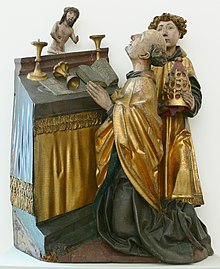Gregor's Mass

The Gregorian Mass , also called Gregorius Mass , is a pictorial theme of Christian iconography . Pope Gregory I is shown at the celebration of Holy Mass in front of an apparition of the incarnate Christ as a man of pain , surrounded by the instruments of suffering . In some depictions, blood flows from Christ's side wound into the chalice .
history
The topos goes back to a late tradition, according to which this miracle is said to have occurred in the church of Santa Croce in Gerusalemme in Rome to cast doubt on the transubstantiation , the transformation of the Eucharistic figures of bread and wine into the body and blood of Christ refute. This tradition is likely to be an extension of a miracle first described by Paulus Diaconus in his biography of Gregory the Great. It is reported here that one day a woman smiled during mass when Gregor handed her communion . When he asked what the smile meant, she replied that it could hardly be the body of the Lord since she had baked the host herself. St. Gregor withdrew communion, prayed and it actually turned into a finger-sized piece of bloody flesh. Upon renewed prayer, it turned back into communion. From then on the woman was unshakable in her faith.
The earliest depiction of this miracle can be found on a mosaic from the 13th / 14th centuries. Century, which is now in the treasury of Santa Croce in Gerusalemme and was supposedly commissioned by Gregory himself.
In the second half of the 15th century, the image motif was widely used on altarpieces and single-sheet prints, especially north of the Alps. One reason for this was undoubtedly that the prayer before a performance of Gregory's mass was connected with an indulgence .
“Our lord ih [esu] s cr [istu] s appeared in rome sant gregorien in the church the da haist porta crucis and appeared in the ob the altar ierusalem and vmb the superfluous frod because of which he received and compared all to whom di kneels with devotion in which he speaks cristi and devotional ain p [ate] rn [oste] r vnd ain aue maria in front of this figure of all aplas who belongs to the above [n] churches [...] "
“Quociens q [ui] s cora [m] armis cr [is] i qui [n] cq [ue] or [ati] ones ap [osto] licas cu [m] qui [n] cq [ue] p [ate ] rn [oste] r [et] aue ma [r] ia deuote dixe [r] it XX milib [us] an [n] oru [m] a penis purgatorij exoneratus erit "
Well-known representations come from Bernt Notke for the Lübeck Marienkirche ( Gregorsmesse (Bernt Notke) , burned in 1942) and Albrecht Dürer . Andreas Tacke suggested the name Simon Franck , court painter to Cardinal Albrecht von Brandenburg , for the above-mentioned master of the Gregorian masses , named after two panels of those motifs in Aschaffenburg (BStGS INv.no.6270 and 6271) .
literature
- Arnold Angenendt : Die Gregorsmesse , in: Offertorium. The medieval sacrifice of mass (= liturgical scientific sources and research. Vol. 101). Aschendorff, Münster 2014, pp. 420-422.
- Romuald Bauerreiß : Pie Jesu. The Man of Sorrows image and its influence on medieval piety , Munich 1931.
- The "Gregorian" Man of Sorrows and the "Sacramentum Sancti Gregorii" in Andechs , in: Studies and communications on the history of the Benedictine order and its branches , Volume 44, New Series 13, Salzburg 1926, pp. 57–79.
- Joseph Borchgrave d'Altena: La messe de Saint Grégoire. In: Bulletin des Musées Royaux des Beaux Arts. Vol. 8, 1959, ISSN 0776-3085 , pp. 3-34.
- David Ganz : Christ in a double vision. The vision of Pope Gregory and the imagination of the beholder. In: Andreas Gormans, Thomas Lente (ed.): The image of the appearance. The Gregory Mass in the Middle Ages (= KultBild. Vol. 3). Reimer, Berlin 2007, ISBN 978-3-496-01313-6 , pp. 208-257. Available online .
- Andreas Gormans, Thomas Lentes (Ed.): The picture of the appearance. The Gregory Mass in the Middle Ages (= KultBild. Vol. 3). Reimer, Berlin 2007, ISBN 978-3-496-01313-6 .
- Peter Hawel: Gregorius Mass. In: Peter Hawel: Lexicon on the art and history of occidental culture. Hawel Verlag, Munich 2005, ISBN 3-9810376-0-X .
- Peter Jezler (Ed.): Heaven, Hell, Purgatory. The afterlife in the Middle Ages. Catalog book. Verlag Neue Zürcher Zeitung, Zurich 1994, ISBN 3-85823-492-3 .
- Esther Meier: The Gregor Mass. Functions of a late medieval image type. Böhlau, Cologne a. a. 2006, ISBN 3-412-11805-2 (also dissertation, University of Marburg 2003), review .
- Alois Thomas: Gregorius Mass. In: Engelbert Kirschbaum (Ed.): Lexicon of Christian Iconography. Volume 2: General Iconography. General iconography. Mythical creatures - cynocephalic. Herder, Freiburg (Breisgau) a. a. 1970, ISBN 3-451-14492-1 , Sp. 199-202.
Web links
- The Gregorsmesse - an image science database
- Search for Gregorsmesse in the German Digital Library
- Search for Gregorsmesse in the SPK digital portal of the Prussian Cultural Heritage Foundation
Individual evidence
- ^ Paulus deacon : S. Gregorii Magni Vita , Migne PL 75,52C-53C. Almost unchanged in the Legenda Aurea
- ↑ Example of a woodcut around 1460/70, quoted from Gunhild Roth, Die Gregoriusmesse and the prayer “Adoro te in cruce pendentem” in single-sheet printing. Legends, visual processing and text tradition using the example of the monogramist d. With text prints, in: Volker Honemann / Sabine Griese / Falk Eisermann u. a. (Ed.), Single-sheet prints of the 15th and early 16th centuries. Problems, Perspectives, Case Studies, Tübingen 2000, pp. 277–324, here p. 292 (No. 4).
- ↑ drain text of a Einblattdrucks of Israhel van Meckenem , reference 11TX01SuMa0060 from the image database gregorsmesse.uni-muenster.de

